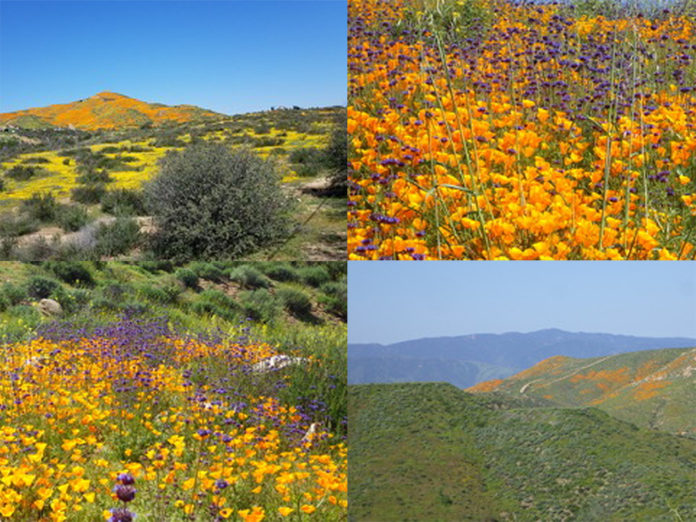According to biology professor Beth Braker, “super bloom” is not a technical term at all, but that does not keep her from using the word to describe the wildflowers currently in bloom on campus and across California. The term describes an abnormally large and vibrant outbreak of wildflowers, often met with general delight.
“[Super bloom] just means that there’s a really spectacular thing [happening] and everyone should go out and look at it,” Braker said.
This season’s super bloom was caused by environmental triggers that create the perfect situation for lots and lots of flowers. According to Braker, one of these environmental triggers is wildfires like those that occurred last fall.
Many local species are “fire followers,” and they flourish when a fire burns competing plants. Plants also thrive because of the fertilizer created from wildfire ash, and some “fire followers” are primed to bloom after seeds heat up or after they sense chemicals that are released by burning. Additionally, wildfires have the effect of wiping out old flowers at the end of their life cycles that don’t bloom as heavily. The other environmental trigger is heavy rainfall following a wildfire, according to Braker.
Dan Snowden-Ifft is a physics professor who founded the Occidental College weather station, located on the roof of the Academic Commons. Along with measuring temperature, wind speed and seismic activity, the weather station measures rainfall.
“Weather affects everything, and it’s an important parameter for a lot of different things, so you should measure it,” Snowden-Ifft said. “[This season] we’re at about twice normal rainfall.”
The weather station has been operating for nine full years, and the record amount of rainfall in a year is 24 inches in 2011, according to Snowden-Ifft. The record is close to being broken this year.
“We’re at about 22 inches, so we need about 2 more inches and then we will have set a record,” Snowden-Ifft said March 19.
Julissa Larios (first year) has lived in East LA for the last eight years, roughly the same amount of time the weather station has been in operation.
“I remember before when it said it would rain, it was like a 50 percent chance of rain, and it usually would drizzle,” Larios said. “Now, we see that it’s going to rain and we actually have to get out shoes and an umbrella because it’s actually going to rain hard.”
Larios said she mostly likes the rain and has enjoyed seeing so much greenery and so many rainbows in the past months.
“It’s really nice after it stops raining because all of the plants on campus come to life, even if [the rain’s] a little bit inconvenient,” Larios said.
According to Braker, while the flowers are spectacular in the San Gabriel Mountains and at the national and state parks, you don’t have to travel that far to experience the super bloom.
“You can just hike up Occidental mountain [Fiji] … and you can see California poppies right up there,” Braker said. “Right outside the door of the biology building, you can see a beautiful native shrub. It’s called wild lilac, and its flowers are kind of cream-colored, not purple.”
Braker and her ecology class are traveling to view the super bloom at the Boyd Deep Canyon, part of the University of California Natural Reserve System near the city of Palm Desert.
“We’re actually going to contribute to some observations of the super bloom,” Braker said. “The scientists [at the nature reserve] and scientists in general are trying to document everything that’s blooming right now and what species are visiting those flowers, like pollinator species.”
Braker said they plan to obtain information via a community-based model with crowdsourcing as a major component.
“People take pictures with their cell phones and upload them onto this site, which is called INaturalist,” Braker said. “INaturalist has a pretty amazing artificial intelligence, and it gives you its best guess, and then the user community gets on there and they all start arguing about it. Eventually, you come up with enough experts that agree and … you can feel pretty confident of that identification.”
According to Braker, in the future, scientists will be able to go back to these records and compare where certain species bloomed year to year. This data will be especially important as scientists study how plants are influenced by climate change over time.
Aside from the scientific value of these observations, Braker also believes in the personal value of witnessing the super bloom and is excited that the flowers are getting more people outside.
“I think that people who spend time out in nature usually get to love nature,” Braker said. “When something like this happens, it’s really so spectacular. And, I think it just speaks to us. It just makes us want to participate.”
![]()




































